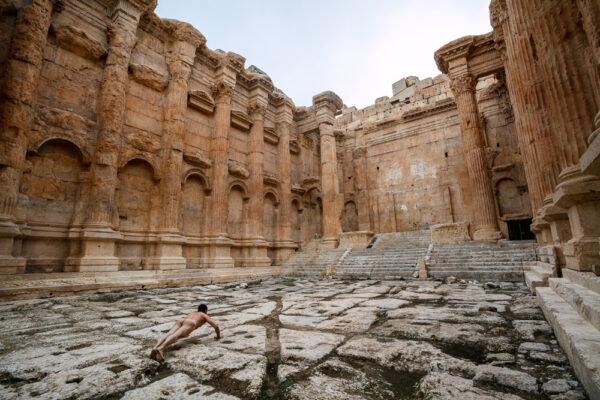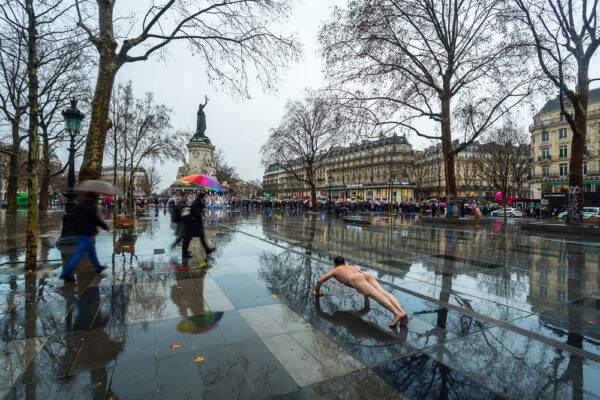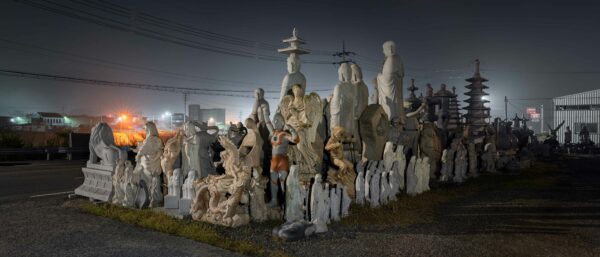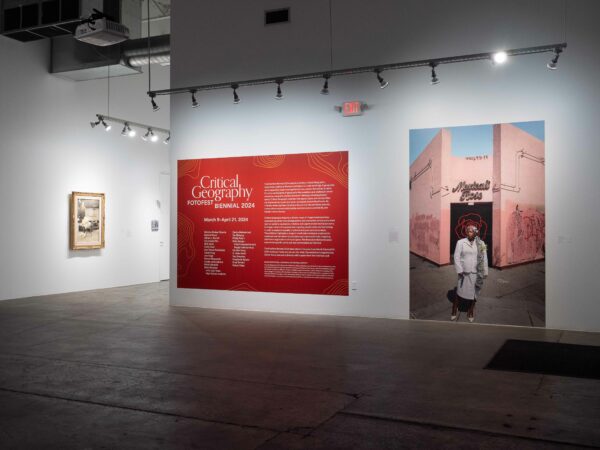Once upon a time, in a place far, far away there existed a geography that wasn’t critical. In my culture we call it the Heavenly City of Kitezh. Jews and Christians call it Eden. Other religions have various designations for that land of milk and honey. Since the moment we’ve left it, there has been nothing but strife and battle. Thus, Critical Geography, the topic of Houston’s most important recurring event, is infinitely expansive.
The curatorial team mostly does a brilliant job of picking and choosing work. There are questions nonetheless. It would be hard to think of a show that does justice to all of the Earth’s contested territories, but there is a Gaza-shaped omission in an exhibit that tries to stay afoot of recent global developments. One can sympathize with the organizers’ reluctance to engage in what is probably the most contentious issue in American society since the Vietnam war. One can’t forget, too, all the firings and divestments that still happen around cultural activism. And yet.

Ou Zhihang, “The Moment, Julius Caesar accelerated the construction in 47 B.C., substantially completed in 60 A.D., Ancient Roman Temple at Baalbek, Lebanon, Work No. 2, Roman ruins at Baalbek, Lebanon,” 2017. From the series “The Moment,” 2003-24. Archival inkjet print. Courtesy of the artist.

Ou Zhihang, “The Moment, Built in 1883, Place de la Republique, Paris, France. On January 30, 2016, there was mass demonstration protesting the extension of the state of emergency due to the terrorist attacks, Place de la Republique, Paris, France,” 2016. From the series “The Moment,” 2003-24. Archival inkjet print. Courtesy of the artist.
The absence is all the more glaring because of the variety of approaches to the topic on display. The show insists that there are many sophisticated ways to depict geography and interact with a location. In a more frivolous corner of the show Chinese artist Qu Zhihang goes naked to do push-ups in historic locations all over the world in his series The Moment (1994-ongoing). Otherwise, the mood here is predictably dark. The recent destruction of Ukraine is shown in stark sepia-toned photographs of the Shilo group (Vlad Krasnoschok and Sergiy Lebedynskyy), hanging unframed as if they just arrived from the print shop. In Clean Hong Kong Action, Siu Wai Hang erases the faces of protesters against inevitable Chinese takeover by poking holes where their faces should be. It is a gesture of care, as the AI-powered surveillance systems are employed by the Chinese government to find and target opposition. But it also looks like somebody used the photographs in a shooting range exercise, which imparts a feeling of real danger that these people are literally surrounded by.
The darkness of night offsets the life size graveyard sculptures in Hyun–taek Cho’s fascinating Stone Market series. The South Korean photographer travels through his country to photograph cemetery sculpture shops and witness the gradual takeover of local beliefs by imported Christianity. Whatever the dilemmas South Korea faces in its bid for fuller integration with the First World markets, the photographs look effortlessly spooky, like a late night horror film. Houston-based Colby Deal masterfully depicts the minutia of Third Ward life and the community representatives, who sometimes are depicted in motion blur, making one think of Ming Smith’s series The Invisible Man.

Cho Hyun-taek, “Ungcheon-eup, Boryeong-si, Chungcheongnam-do,” 2020. From the series “Stone Market,” 2019–22. Archival inkjet print. Courtesy of the artist.
Other locations in the US and globally have their own eulogizers, some eloquent, others less so. But the exhibition works so well precisely because it doesn’t treat its theme as dogma. It frequently strays into side lanes, and some of them are fascinating. A whole section of the show is dedicated to a 1983-1985 body of work by a Chekh photographer Libuše Jarcovjáková, who went to the then Socialist Prague’s gay joint, the T-Club, and took photos of its patrons. While homosexuality was decriminalized in Chekhoslovakia as early as 1962, in same year as the first state in the union, it had not been seen in a positive light. Jarcovjáková’s photos, snapped with the messiness of Weegee and sympathy of Nan Goldin, present a jolly crowd of drag queens and gay men, affirming the fact that life went on behind the Iron Curtain. Sexuality and its implications are further explored in a video installation by French artist Ethel Lilienfeld. Here, we are witnessing a mysterious drama of two women hypnotized by a well of eternal youth, the water in which makes them turn into living Instagram filters.
Lilienfeld’s staging of a ritual in an Internet-saturated reality makes one look at the topic of the FotoFest differently. With photography there’s always a dangerous possibility of being insistently invited into a reality that you know nothing about. The picture is presented as factual, and not as a light imprint on photosensitive materials. How can we be reliably sure that a photographic image shows what its maker purports to show? A mere decade or so ago this cursed duplicity of photography was still a subject of many a book. Now, with exceptional advances in inter-connectedness, we are seemingly past this. Every photo can be contextualized by the subjects, provided they are given an opportunity to speak out. Exhibit one: 2016 internet phenomenon #facesofdepression, a world-wide effort by those suffering from depression to explain that this disorder can be invisible to the naked eye. How can we know, however, that the voices are genuine and their meanings are not lost in translation? Enter exhibit two: Caleb Fung’s Escape to the Red Planet.
Caleb Fung photographs banyan trees in Hong Kong for a project that is displayed only partially, without the science-fiction element that makes it complete. Somber, low contrast shots depict unimaginably complex entanglements of trunks, bursting out of city concrete with a vivacity that intervenes in the urban fabric with primordial energy. Faced with a potential destruction of one of those trees, Fung imagines a scenario where the trees are transported to Mars and find a landscape as fascinating as they are in the deserted dust plains of the Red Planet. On his website, Fung explains the project as a reaction to his apartment building’s homeowner association’s decision to get rid of a tree on the property. The FotoFest label goes way further and connects the disappearance of banyan trees to the Chinese administration efforts to control and standardize Hong Kong. Which version is true? Is the artist understandably wary of assigning direct political meanings to his work? Or are the organizers of FotoFest elevating a lyrical impulse to preserve great trees into something that serves their need to add topical drama? Or both?
And with these questions we’re back in the precarious territory mapped decades ago by Michelangelo Antonioni’s Blow Up. True? False? Performative? State-sponsored extermination or an argument between neighbors? Or, sorry for the redundancy, both? Tackling geography as a topic, FotoFest plunges right in the middle of a minefield. It couldn’t be different, surely, outside of Eden.
The FotoFest Biennial 2024 Critical Geography is on view through April 21 at The Silos at Sawyer Yards




